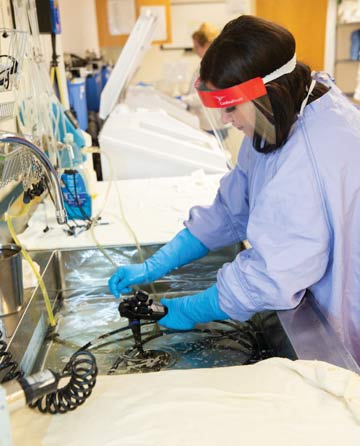Leak testing is important because it's used to identify areas of the scope that are damaged. Identifying leaks can prevent additional damage caused by fluid invasion during subsequent reprocessing and, most importantly, prevent fluid harbored
in damaged areas from cross-contaminating patients.
Scopes that fail leak tests can have damage that was difficult to spot, or damage to an internal component that cannot be seen at all. For example, the control body contains delicate O-rings that can be disturbed, without any signs of external
damage like cracks, if the scope is dropped or mishandled.
Unfortunately, leak testing is one of the most misunderstood and frequently missed steps in endoscope reprocessing. Manual dry or wet tests are common methods for leak testing, but there are several critical steps that need to be completed
in order to perform them correctly.
- Manual leak test. The scope is pressurized and manipulated while the tech observes a pressure gauge, looking for changes in pressure.
- Wet test. The scope is pressurized and submerged in a sink of clean water. A tech manipulates the scope and looks for bubbles exiting the scope.
Both dry and wet leak tests rely on the attention and interpretation of the person performing the work. Sometimes, defects are missed. An automated leak tester can help simplify the process to make sure it's done correctly and consistently.
There are several models of automatic leak testers available. They can be expensive ($3,000 to $5,000), but the cost benefit is easily justified. Automated leak testing technology is more sensitive and consistent than using an un-aided
eye to watch a pressure gauge during a dry test or searching for bubbles during a wet test.
Damage to scopes can also be caught early using an automated tester, so repairs and the costs associated with them should be relatively small, compared with damage that has to be obvious enough to catch during manual testing. Catching defects
early also lowers cross-contamination risks.
.svg?sfvrsn=be606e78_3)

.svg?sfvrsn=56b2f850_5)